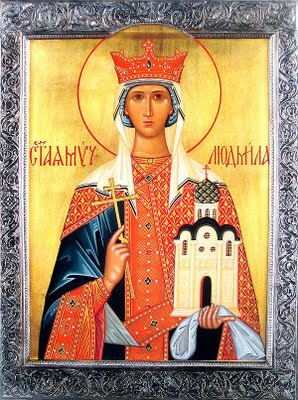|
|||
|---|---|---|---|
| This weekly bulletin insert complements the curriculum published by the Department of Christian Education of the Orthodox Church in America. This and many other Christian Education resources are available at http://dce.oca.org. | |||

The Church honors a princess of Bohemia, part of what is now the Czech Republic. She is the Holy Martyr Ludmilla. She and her husband, a Czech prince, were both baptized in about 871 by Saint Methodius, one of the two great evangelists--the other is Saint Cyril--who together are known as the Enlighteners of the Slavic Peoples. As new Christians instructed and inspired by those two great men, Ludmilla and her husband enthusiastically built the first Christian church in Bohemia, near Prague. They built other churches as well, provided for clergy to serve in them, and supported the spread of the faith among their people in every way they could. Pagan opposition was so strong that for a while the couple had to leave the country, but when they returned they continued their work. Ludmilla was widowed quite early in life, her husband dying in his thirties. After this their son married a woman named Dragomira who was happy to have a royal husband, but whose Christianity was only a façade; she secretly kept her pagan beliefs and customs. Ludmilla took most of the responsibility for raising the young couple's child, her grandson, whose name in Czech was Vatslav but who is better known as Wenceslas. She brought him up as a devout Christian and strongly influenced his attitudes. He is the one so admiringly described in the Christmas carol as caring for the poor by taking food to them on a bitterly cold night, and being concerned for the young page who accompanied him. Dragomira was not pleased with Ludmilla's authority over her son. When her husband died she became regent for the young and inexperienced Wenceslas, who took the throne in 921. That was her chance, and she took it, encouraging pagan customs in the court and among the people. Her hatred of Ludmilla became so overwhelming that even though the older woman had moved to a distant town, she wanted to destroy every vestige of her influence. She sent seasoned assassins to murder Ludmilla, and they did their deadly work. Her loving grandson Wenceslas placed her body in the Church of Saint George in Prague. Ludmilla and Wenceslas, who was later killed by his own brother, are both martyred saints of the Church. In II Corinthians 4: 6-15 Saint Paul describes the many kinds of suffering he has undergone without ever having been undone by them. He writes of being "afflicted but not crushed, perplexed but not despairing, persecuted but not forsaken, struck down but not destroyed." Paul adds, "For while we live we are always being given up to death for Jesus' sake." Saint Ludmilla was one who was "always being given up to death for Jesus' sake" because the forces of paganism constantly stalked her and her family, ready to kill them. But she never wavered, and she would no doubt say with Paul, "We do not lose heart" (4:1). |
|||
